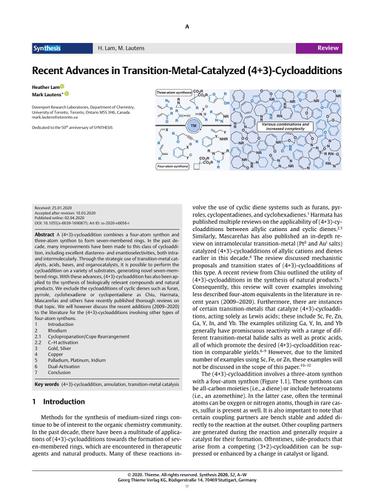Our official English website, www.x-mol.net, welcomes your
feedback! (Note: you will need to create a separate account there.)
Recent Advances in Transition-Metal-Catalyzed (4+3)-Cycloadditions
Synthesis ( IF 2.2 ) Pub Date : 2020-04-02 , DOI: 10.1055/s-0039-1690875 Mark Lautens 1 , Heather Lam
Synthesis ( IF 2.2 ) Pub Date : 2020-04-02 , DOI: 10.1055/s-0039-1690875 Mark Lautens 1 , Heather Lam
Affiliation

|
A (4+3)-cycloaddition combines a four-atom synthon and three-atom synthon to form seven-membered rings. In the past decade, many improvements have been made to this class of cycloaddition, including excellent diastereo- and enantioselectivities, both intra- and intermolecularly. Through the strategic use of transition-metal catalysts, acids, bases, and organocatalysts, it is possible to perform the cycloaddition on a variety of substrates, generating novel seven-membered rings. With these advances, (4+3)-cycloaddition has also been applied to the synthesis of biologically relevant compounds and natural products. We exclude the cycloadditions of cyclic dienes such as furan, pyrrole, cyclohexadiene or cyclopentadiene as Chiu, Harmata, Mascareñas and others have recently published thorough reviews on that topic. We will however discuss the recent additions (2009–2020) to the literature for the (4+3)-cycloadditions involving other types of four-atom synthons.
中文翻译:

过渡金属催化的(4 + 3)-环加成反应的最新进展
(4 + 3)-环加成结合了四个原子的合成子和三个原子的合成子,形成七元环。在过去的十年中,对这类环加成反应进行了许多改进,包括在分子内和分子间均具有出色的非对映选择性和对映选择性。通过战略性地使用过渡金属催化剂,酸,碱和有机催化剂,可以在多种底物上进行环加成反应,从而生成新颖的七元环。随着这些进展,(4 + 3)-环加成也已被用于合成生物学上相关的化合物和天然产物。我们排除了环二烯(如呋喃,吡咯,环己二烯或环戊二烯)的环加成,因为Chiu,Harmata,Mascareñas等最近发表了对该主题的详尽评论。
更新日期:2020-04-02
中文翻译:

过渡金属催化的(4 + 3)-环加成反应的最新进展
(4 + 3)-环加成结合了四个原子的合成子和三个原子的合成子,形成七元环。在过去的十年中,对这类环加成反应进行了许多改进,包括在分子内和分子间均具有出色的非对映选择性和对映选择性。通过战略性地使用过渡金属催化剂,酸,碱和有机催化剂,可以在多种底物上进行环加成反应,从而生成新颖的七元环。随着这些进展,(4 + 3)-环加成也已被用于合成生物学上相关的化合物和天然产物。我们排除了环二烯(如呋喃,吡咯,环己二烯或环戊二烯)的环加成,因为Chiu,Harmata,Mascareñas等最近发表了对该主题的详尽评论。











































 京公网安备 11010802027423号
京公网安备 11010802027423号